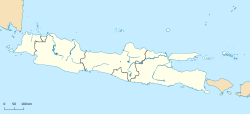| Mendut | |
|---|---|
| Native name ꦩꦼꦤ꧀ꦢꦸꦠ꧀ (Javanese) | |
 Northen view of Candi Mendut | |
| Location | Magelang, Central Java |
| Coordinates | 7°36′20″S110°13′44″E / 7.6055°S 110.229°E |
| Built | Originally built in the 9th century during the reign of the Sailendra Dynasty |
| Restored | 1925 |
| Restored by | Theodoor van Erp |
| Architect | Gunadharma |
| Type | Cultural |
| Criteria | i, ii, vi |
| Designated | 1991 (15th session) |
| Part of | Borobudur Temple Compounds |
| Reference no. | 592 |
| Region | Southeast Asia |
Mendut is a ninth-century Buddhist temple, located in Mendut village, Mungkid sub-district, Magelang Regency, Central Java, Indonesia. The temple is located about three kilometres east of Borobudur. Mendut, Borobudur, and Pawon, all of which are Buddhist temples, are located in one straight line. There is a mutual religious relationship between the three temples, although the exact ritual process is unknown. [1]















